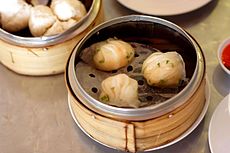- Har gow
-
Har gow 
Origin Alternative name(s) Xia jiao, also spelled har gau, har kau, har gao, ha gao, ha gow, ha gau, har gaw, ha gaw, har kaw, ha kaw, ha gaau, har cow, har gaau, or other variants Place of origin Guangdong, China Region or state Cantonese-speaking areas Dish details Course served Dim sum Main ingredient(s) Glutinous rice wrapper, shrimp, cooked pork fat, bamboo shoots, scallions, cornstarch, sesame oil, soy sauce, sugar, and other seasonings Har gow Traditional Chinese 蝦餃 Simplified Chinese 虾饺 Cantonese Jyutping haa1 gaau2 Hanyu Pinyin xiā jiǎo Literal meaning shrimp dumpling Transcriptions Mandarin - Hanyu Pinyin xiā jiǎo Min - Hokkien POJ hê-kiáu
hoê-kiáuCantonese (Yue) - Jyutping haa1 gaau2 Har gow or Xiā jiǎo is a traditional Chinese dumpling served in dim sum.[1] It is listed at number 34 on World's 50 most delicious foods readers' poll complied by CNN Go in 2011.[2]
Contents
Name
The dumpling is sometimes called a shrimp bonnet for its pleated shape. Traditionally, har gow should have at least seven and preferably ten or more pleats imprinted on its wrapper. This dish is often served together with sieu mai; when served in such a manner the two items are collectively referred to as hargow-sieu mai (蝦餃燒賣).[3][4]
Description
The wrappers are made with boiling water, to which wheat starch, tapioca starch, oil and a small amount of salt are added.[1] The filling contains shrimp, cooked pork fat, bamboo shoots, scallions, cornstarch, sesame oil, soy sauce, sugar, and other seasonings.[1] The pouch-shaped dumpling is then steamed in a bamboo basket until translucent; at the table it is usually dipped in soy sauce, or red color rice vinegar. When the dough for the wrapper is properly prepared and cooked, the dumpling has a slightly sticky, chewy texture. The shrimp are not overcooked, so they retain a slightly crisp texture. Ingredients vary regionally, but most versions contain sesame oil, salt, sugar.[1] Other versions may contain oyster sauce, water chestnuts, or ginger.
This dish is said to be the one that the skill of a dim sum chef is judged on. The skin must be thin and translucent, yet be sturdy enough not to break when picked up with chopsticks. It must not stick to the paper, container or the other har gow in the basket. The shrimp must be cooked well, but not overcooked. The amount of meat should be generous, yet not so much that it cannot be eaten in one bite.
See also
References
- ^ a b c d Hsiung, Deh-Ta. Simonds, Nina. Lowe, Jason. [2005] (2005). The food of China: a journey for food lovers. Bay Books. ISBN 978-0681025844. p41.
- ^ CNN Go Your pick: World's 50 most delicious foods 7 September 2011. Retrieved 2011-10-11
- ^ Big5.China.com.cn. "China.com.cn." 廣州茶飲. Retrieved on 2009-03-17.
- ^ Yahoo.com. "Yahoo.com." 街坊盅頭飯. Retrieved on 2009-03-15.
American cuisine Latin AmericaAsian cuisine East AsiaChinese: Baozi · Ci fan tuan · Dim sum · Fun guo · Har gow · Hujiao bing · Jau gok · Jiaozi · Lo mai gai · Shengjian mantou · Shumai · Siopao · Suanla chaoshou · Tang bao · Tangyan · Taro dumpling · Wonton · Xiaolongbao · Zhaliang · Zongzi · Other: Akashiyaki · Buuz · Dango · Khuushuur · Mandu · Mandugwa · Manduguk · Mitarashi dango · MomoSouth East AsiaVietnamese: Ba-wan · Bánh bao · Bánh chưng · Bánh lá · Bánh tẻ · Bánh tét · Other: Caozai Guo · Kueh tutu · Kuih kochi · NagasariWest AsiaNorth AsiaEuropean cuisine Bryndzové halušky · Halušky · Kalduny (Kundumy) · Kopytka · Pierogi · Scovardă · Shlishkes · Strapačky · Uszka · VarenykySouthern EuropeCentral EuropeCapuns · Kluski · Knedle · Knödel · Maultasche · Mohnnudel · Pickert · Schupfnudel · Silesian dumplingsWestern EuropeNorthern EuropeOther AustraliaCategories:- Chinese cuisine stubs
- Cantonese cuisine
- Cantonese words and phrases
- Dumplings
- Dim sum
- Shrimp dishes
Wikimedia Foundation. 2010.
